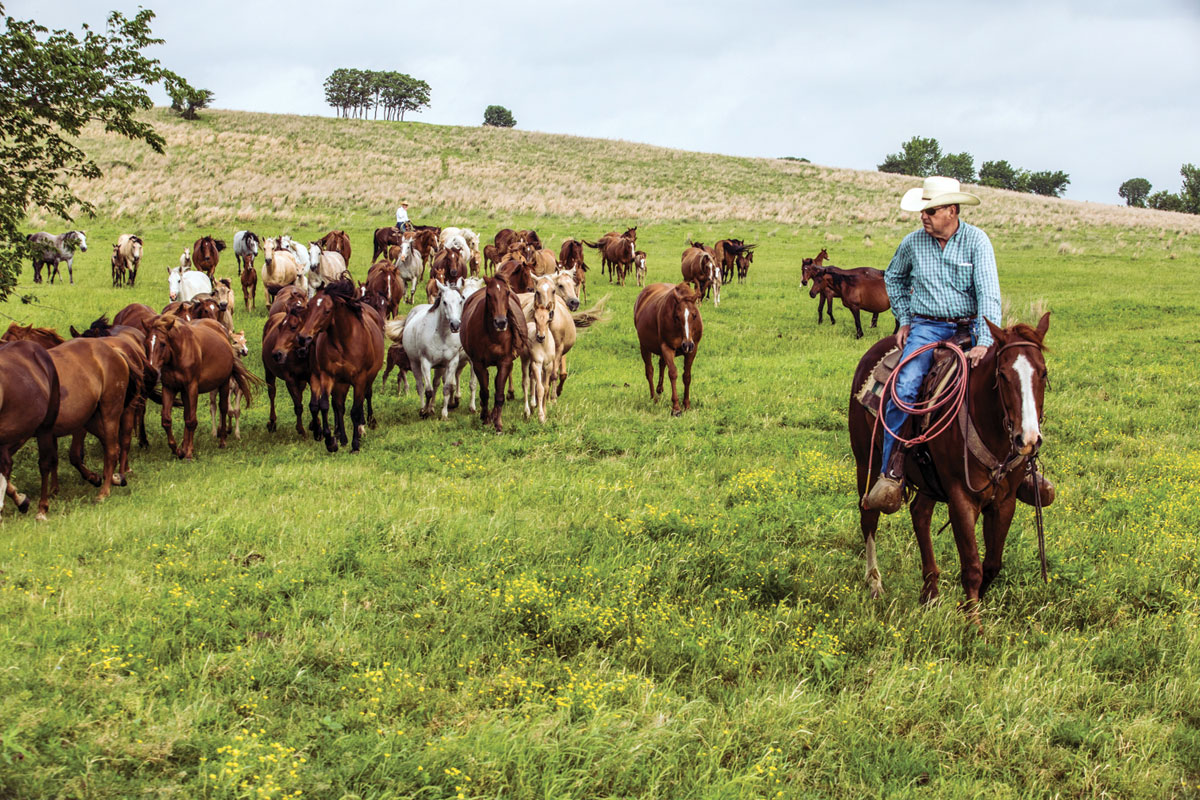
The Armitage family sees the future in value added females
A Bar Ranch encompasses approximately 7,000 acres in Mayes, Rogers and Craig counties in Oklahoma. Although the Armitage family is in the horse business, the main thrust of their operation is replacement females.
“The big emphasis is, we’re always marketing cattle,” Turner Armitage said. “Replacements are always available from our sales or private treaty.”
Mike and Martha Armitage built their ranch starting with the headquarters in Claremore, Okla. The ranch now also includes branches in Craig and Mayes counties, and Martha’s home place near Welch, Okla.
Sons Merrit and Turner were raised on the ranch where they now live with their wives. Merrit has two young children.
The A Bar runs 2,000 commercial cows that produce both spring and fall calves. They use virgin registered Angus bulls. The calves on the ground now are by Express bulls, but the next crop will be sired by a Shilling-bred bull. After the bulls prove their worth producing a calf crop, they are offered for purchase in one of the ranch’s production sales.
The heifers are kept and steers are sold on contract. About a year and a half ago, the family started their own marketing agency, Armitage Livestock.
“I think the future of (cattle) marketing is in value added females,” Merrit said. To add more value to heifers, they are sold bred at the September sale. The heifers are sonogramed to identify 30-day breeders. By identifying early maturing females who breed in the first 30 days, fertility is increased both for the Armitage herd and for the customers’ herd.
Embryos are aged, so a set of bred heifers can be put together that will calve within a week or two of each other. Merrit said aging embryos by ultrasound can identify the calving date within a 10-day window.
The A Bar offers four production sales each year. Cows are sold in May. June is the horse sale and ranch horse futurity. The September sale offers pairs and bred heifers, and the November sale includes colts from the remuda, bulls and cows.
A Bar strives to have repeat customers, and the way to do that is produce the best for their customers.
“We sell these heifers on a heavy sort,” Turner said. “We may have a set of ultra baldies or a set of super blacks, some have a little more ear.” This is to tailor lots for different parts of the country. For instance black heifers with a little ear might be what Texas producers are looking for, while baldies with no ear might appeal to Nebraska or Kansas buyers. These heifers will make moderate-sized cows, averaging 1,100 pounds with deep bodies and a maximum amount of internal dimension.
The ranch has been in the horse business since the beginning.
“We want to raise multi-purpose horses that can go to the cutting pen or work on the ranch,” Merrit said.
The bloodlines used and the crosses made have a view to that end. To support evidence of the horses’ abilities, A Bar has a ranch horse show futurity for colts raised on the ranch. Two-year olds purchased at the June sale will be eligible to enter the show as 4 and 5-year olds. This year the futurity will have $20,000 added money. This is the fifth year for the futurity. An owner may show the horse, then offer it in the sale.
All the 2-year-olds in the sale are started under saddle.
“We make sure we have a good hand starting them,” Turner said. At present that colt starter is Dylan Steeley, a graduate of Oklahoma State University’s equine program, which includes colt starting.
Seven different studs are used in the pasture breeding program. The ranch has a Metallic Cat stud in training with Boyd Rice nominated for the National Cutting Horse Association futurity this year.
“He’s royally bred and he fits our program,” Turner said. “We’ll see what happens.”
Another Metallic Cat bred stud is on mares after winning in both ranch horse shows and cuttings under trainer Tommy Marvin.
Boonshine was the first home-raised stud to be used at A Bar, a son of Boonlight Dancer and a Shining Spark daughter.
A Tankqueray Gin son raised on the Cross Bell ranch at Copan, Okla., is on a set of mares also from the Cross Bell.
Son of Sugar has been a good bloodline for the ranch.
A Bar produces approximately 60 foals per year, 40 of which will be marketed in November as weanlings. Twenty stud colts will be kept until they are 2 years old to be started under saddle and sold at the June sale.
“We’re putting heavy pressure on the mare side,” Turner said, continuing that the mare’s ability and temperament is just as important to getting a good individual as the stud selection.
Mike serves on both the Oklahoma Cattlemen’s Association and American Quarter Horse Association boards, and he devised the internship to bring the horse and cow worlds together.
“It’s available to OSU juniors and seniors,” Merrit said. “It’s a paid internship plus a scholarship. They’ll work at A Bar through the summer, along with attending and working at events such as the OCA convention and Ranching Heritage Show at Amarillo. This ties the cattle and horse worlds together.”
This is the fifth year interns have worked at A Bar. “I’m glad OCA and AQHA decided to come together,” Merrit said.
The OSU horse program has benefited from contacts made through the internship. Students in the equine program now start colts raised in the OSU remuda.
“They’ve had a lot of good gifted mares and outside semen gifts,” Merrit said. “They can put a horse in our June sale, so they learn how to get a horse ready to show and how to market him for sale.” Merrit helps the students by producing videos and taking photos of horses the students offer for sale.






